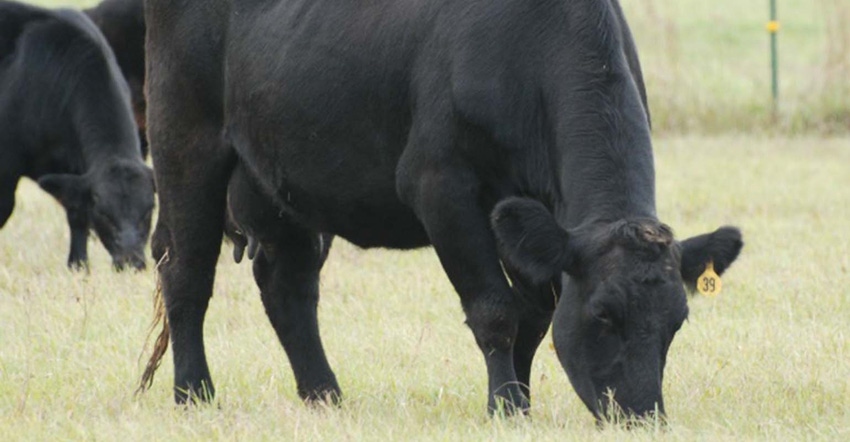October 30, 2018

Bloat in livestock is a common problem for producers, especially when animals graze on lush pastures or are fed grain to boost gains, says Dr. David Fernandez, Extension livestock specialist for the University of Arkansas at Pine Bluff School of Agriculture, Fisheries and Human Sciences. Because bloat can kill ruminant animals very quickly — often in a matter of hours — producers should be aware of the causes of bloat and potential treatment or prevention methods.
“Bloat occurs when gasses trapped in the rumen — the first stomach of a ruminant — press against the animal’s diaphragm, preventing it from breathing,” he said. “Often the only sign of bloat is a dead animal in the pasture.”
Fernandez said methane and hydrogen gasses are normal byproducts of fermentation in the rumen. Normally the gas accumulates above the feed and fluids in the rumen and exits when the animal burps. Under certain conditions, however, proteins from plants can form tiny bubbles around these gasses, trapping them in the rumen in the form of a frothy substance.
“When it’s visible, bloat can appear as swelling on the left side of an animal,” he said. “If you tap firmly on the swelling, it will sound like a drum.”
Pasture bloat is the most common form of boat. Livestock grazing on pastures with many high-protein forages such as legumes and clover are more likely to suffer from bloat.
Some high-protein forages are high in condensed tannins, which reduce the potential for bloat by binding other proteins and slowing the rate of digestion. These forages include sainfoin, crown vetch, milk vetch, fenugreek, and birdsfoot trefoil.
Young grain crops and brassicas such as turnips and rape can also contribute to bloat in livestock, Fernandez said.
“Grain bloat seems to be caused by a slime-producing bacterium that thrives on high carbohydrate diets and lower pH levels,” he said. “The combination of bacterial slime, lower pH and small particle size of grain diets — especially those of ground corn — creates foam leading to bloat.”
Young, bottle-fed livestock under three weeks of age are prone to abomasal bloat. Infrequent feedings of cool milk that can be consumed rapidly contribute to this type of bloat.
“Kids, calves or lambs overeat during these infrequent feedings,” Fernandez said. “The milk curdles in the abomasum and remains for some time. Current thinking is that bacteria begin to ferment the milk in the abomasum and froth develops.”
Signs that a young animal has abomasal bloat include grinding of the teeth and salivation, as well as the animal looking depressed and refusing to eat. Because the abomasum swells, a “tinkling” or splashing sound can be heard if the animal is shaken.
Unfortunately, treatment outcomes for abomasal bloat are usually poor, he said.
“Bloat can also occur when an object blocks an animal’s esophagus,” Fernandez said. “Your animal may have swallowed an apple, potato or something else that can become lodged in the esophagus and prevent gas from escaping.”
Animals trapped on their back or side can also become bloated when the rumen contents block the esophagus.
“In this case, the obstruction must be dislodged quickly,” he said. “Producers should remember to stand clear of the animal’s mouth when dislodging the obstruction. The gas can escape very suddenly and bring some rumen contents with it.”
There are several over-the-counter products that contain poloxalene, which is a very effective bloat preventative and bloat reliever, Fernandez said.
If a producer doesn’t have any poloxalene-based products on hand, mineral or vegetable oil can reduce the surface tension of the foam and allow gas to escape. Dosage for cattle is a pint to a quart. Liquid soaps are also effective — a few ounces of dishwashing soap in water will break down the foam and allow gas to escape.
“Old-timers used a bloat needle or even a knife to puncture the rumen and allow gas to escape, but this is a dangerous and drastic step which should only be taken if the animal’s life is in immediate danger,” he said. “The risk of infection and peritonitis is too high to undertake this step lightly.”
To help prevent bloat in their animals, producers should maintain adequate roughage in the diets of animals on high grain diets.
“When introducing livestock to pastures containing high levels of bloat-promoting forages, make sure to do it gradually,” Fernandez said. “Feed the animals grass hay before allowing them to graze for an hour or so. Gradually increase grazing time, while reducing hay feeding, and be sure to keep an eye on your animals.”
For more information on bloat or other livestock topics contact Fernandez at (870) 575-7214 or [email protected].
About the Author(s)
You May Also Like




